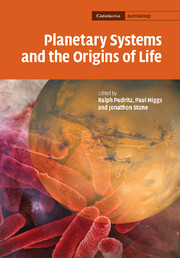Book contents
- Frontmatter
- Contents
- List of contributors
- Preface
- Part I Planetary systems and the origins of life
- Part II Life on Earth
- 6 Extremophiles: defining the envelope for the search for life in the universe
- 7 Hyperthermophilic life on Earth – and on Mars?
- 8 Phylogenomics: how far back in the past can we go?
- 9 Horizontal gene transfer, gene histories, and the root of the tree of life
- 10 Evolutionary innovation versus ecological incumbency
- 11 Gradual origin for the metazoans
- Part III Life in the Solar System?
- Index
11 - Gradual origin for the metazoans
Published online by Cambridge University Press: 13 August 2009
- Frontmatter
- Contents
- List of contributors
- Preface
- Part I Planetary systems and the origins of life
- Part II Life on Earth
- 6 Extremophiles: defining the envelope for the search for life in the universe
- 7 Hyperthermophilic life on Earth – and on Mars?
- 8 Phylogenomics: how far back in the past can we go?
- 9 Horizontal gene transfer, gene histories, and the root of the tree of life
- 10 Evolutionary innovation versus ecological incumbency
- 11 Gradual origin for the metazoans
- Part III Life in the Solar System?
- Index
Summary
Introduction
Darwin was obsessed with origins. The book with which he distinguished himself as among the greatest thinkers ever to have walked on Earth, The Origin of Species by Means of Natural Selection or, The Preservation of Favoured Races in the Struggle for Life, was intended as only an abstract to a ‘big species book’ (Gould, 2002) about organisms and their environments and how they interact to elicit change over time. In a letter to Hooker (Darwin, 1871), Darwin speculated on how life, itself, might have originated, including the now infamous notion that it started in a ‘warm little pond’. As Einstein would do for physics with space and time less than a half-century later (Minkowski, 1952), Darwin, in his magnum opus and personal correspondence, accomplished for biology: ecology and evolution were inextricably linked forevermore.
But origins posed problems for Darwin, even concerning particular groups, such as metazoans (i.e., animals): ‘[t]here is another and allied difficulty, which is much graver. I allude to the manner in which numbers of species of the same group, suddenly appear in the lowest known fossiliferous rocks’ (Darwin, 1859; in the section titled ‘On the Imperfection of the Geological Record’).
In this chapter, we consider the origin of metazoans as a model for the origin of life. Considering only a group within the tree of life offers us three advantages in demonstrating our thesis (which is described in the subsequent paragraph).
- Type
- Chapter
- Information
- Planetary Systems and the Origins of Life , pp. 210 - 222Publisher: Cambridge University PressPrint publication year: 2007
- 1
- Cited by



